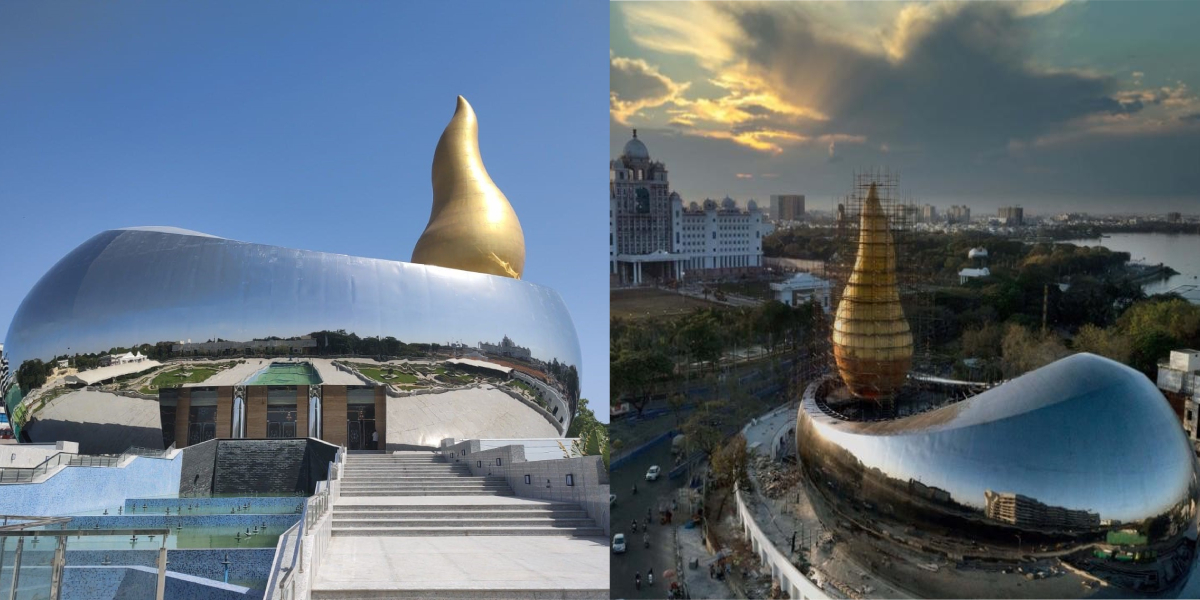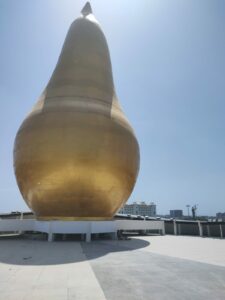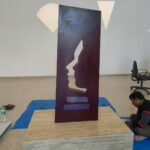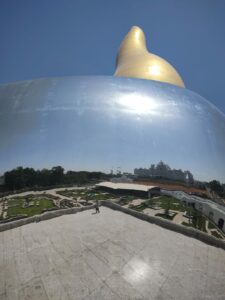The ₹177.5-crore structure will also house a museum an audio-visual hall, photo gallery, a restaurant, and a parking space for over 700 vehicles.

Telangana Martyr's Memorial was inaugurated by CM K Chandrashekar Rao on 22 June. (Supplied)
Telangana will see the launch of yet another landmark on 22 June. The Martyrs’ Memorial will be third over the past two months. Incidentally, Telangana Martyrs’ Day is observed every year on 2 June.
The edifice, in the shape of an ellipse, also resembles a traditional earthen oil lamp. It is dedicated to those who lost their lives during the Telangana movement, demanding statehood.
Located on the end of the Hussain Sagar stretch near Lumbini Park, the structure stands right in front of the newly-inaugurated Telangana Secretariat. The world’s tallest BR Ambedkar statue — at 125 feet — is also visible from the site.
The Martyrs’ Memorial stands 161 feet (over 49 metres) tall and is claimed to be the world’s largest seamless stainless steel structure — resistant to rusting and corrosion — with a mirror finish.
Days before its inauguration, when South First visited the Memorial, work was in full swing to make final arrangements.
While the previous Telangana Martyrs’ Memorial, also called the Gun Park, was designed by noted sculptor Aekka Yadagiri Rao, the new one has been designed by M Venkata Ramana Reddy.
“The shape of an oil lamp and golden flame on top are markers of respect and tribute to the martyrs who fought over the decades for Telangana. It will also help the future generations to notice the sacrifice made by them,” Reddy, also the concept designer, told South First.
The contract for the project was handed over to Hyderabad-based firm KPC Project Limited, which also executed the Ambedkar statue project.
The construction of the structure started in 2019. “Around 5,000 people worked on it over the past four years,” Reddy said.
The ₹177.50-crore project is spread across 3.36 acres land with a built-up area of 2.85 lakh square feet.
The structure, in many ways, resembles the sculpture “The Bean” — formally titled “Cloud Gate” — in Chicago’s Millenium Park, “The Bubble” in the western Chinese city of Karamay, referring to the oil fields there, and somewhat the Future Museum in Dubai.
“It is the world’s largest seamless stainless façade with a mirror finish. Engineers have used as many as 3,000 stainless steel plates, which were cladded in Dubai, and assembled and welded in Hyderabad,” Reddy said.
The golden-coloured flame on top of the sculpture is made of carbon steel, and is said to withstand wind speeds up to 130 kmph.
The exterior of the highly polished structure is built of 4-millimetre stainless steel to resist high temperatures from the outside, and puff material and the GFRC sheets inside will help in keeping it cool.

Golden flame at the top of Telangana Martyr’s memorial. Telangana Secretariat and Ambedkar statue can also be seen in the background. (Ajay Tomar/South First)
“It is a fully air-conditioned structure with no ventilation. Only the floor is made of concrete,” said Reddy.
A total of 120 tonnes of mild steel, 100 metric tonnes of stainless steel with mirror finish, and around 1,700 metric tonnes of structural steel have been used in the construction of Telangana Martyr’s memorial.
For the golden flame, 15 metric tonnes of low-carbon steel has been used. It will “burn” 24 hours a day.
“We have also used type-316L stainless steel because it is more stable in high-temperature and corrosive environments than plain 316. Lots of toxic elements get released in the air as it is adjacent to Hussain Sagar so we took precautions,” Reddy explained.
The ellipse-shaped Memorial has a major-axis length of 54 metres and a minor-axis length of 37 metre.
Its height is 26 metres on one side and 18 metres on the other side.
The overall height of the golden flame is 45 metres from the ground surface, and 26 metres from the terrace, according to the Telangana government,


Apart from the splendid artwork capturing the eyes of several who pass- the Tank Bund, Telangana Martyrs’ Memorial has other features as well.
The six-floor structure, including two basement floors, houses a museum, an audio-visual hall that has 80 seats on the first floor with a 170-inch LED screen, a 650-seater convention centre-cum-museum and a photo gallery on the second floor, a restaurant at the top floor along with open terrace seating and a mezzanine floor with glass-roof restaurant.
The sculpture can accommodate 335 cars and 400 bikes on the two basement floors.
“Whenever I used to travel to other countries, I noticed sculptures only for aesthetic purposes. So we designed two halls in which programmes and the events such as film screening, talks and others about the martyrs can be organised,” Reddy observed.
A flagship project of the Telangana government, the Martyrs’ Memorial is the fifth design Reddy submitted to Chief Minister K Chandrashekar Rao after the previous four were not approved.
Meanwhile, along with the Telangana Secretariat, Ambedkar, Buddha statue, Birla Mandir and NTR Park are also visible from the Martyr’s Memorial
After two phases of the Telangana movement, in which over 2,000 people reportedly lost their lives, it was finally bifurcated from Andhra Pradesh on 2 June, 2014.
The first phase, which was in the 1950s and 1960s, witnessed mulkhi agitation — a political movement for safeguarding employment for the natives of Hyderabad.

A close-up view of the Telangana Martyr’s memorial, stainless steel structure with a mirror finish. (Ajay Tomar/South First)
“In 1952, there was a huge protest near City College of Hyderabad where seven students were killed in police firing. In the 1969 movement, the police rampantly opened fire everywhere and almost 376 people died in the police firing,” sociology professor Ghanta Chakrapani, a veteran of the movement, told South First.
He recollected that the movement’s aim was to remain independent as scores of people from the then Madras state and Andhra Pradesh moved to Hyderabad after the first elected government was sworn in in 1952.
“Locals felt that employment opportunities were threatened by the outsiders. So they wanted ‘ghair mulki go back‘ (other-state people go back) and ‘neelu nidhulu niyamakalu’ (water, resources, and employment). That’s why the movement started,” Chakrapani asserted.
Chakrapani remembered several people, including Telangana Kala Samithi founder Belli Lalitha. “The state used to suppress the voices during the Telangana movements,” he said.
He also pointed out how Tank Bund hosted several landmark and very crucial movements during the Telangana agitation, such as a Million March.
“Thousands of people sacrificed their lives, which is why the government has decided to commemorate them, their sacrifices, work, and fight. They deserved a beautiful symbolical memorial in the heart of Hyderabad. It is a tribute to departed souls and also a memorial of a great movement (Telangana movement),” he said.

May 14, 2024

May 13, 2024

May 13, 2024

May 13, 2024

May 13, 2024

May 13, 2024